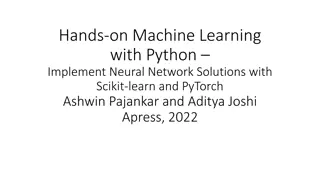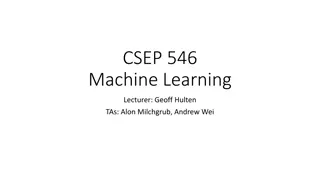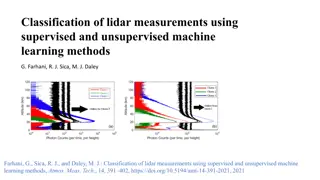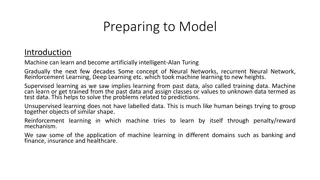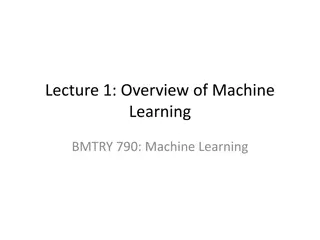
Understanding Feature Importance in Machine Learning
Learn about feature importance in machine learning, including its significance, measurement methods, global vs. local importance, and the use of SHapley Additive ExPlainers for accurate assessment. Enhance your understanding of model interpretability to make informed decisions in predictive analysis.
Download Presentation

Please find below an Image/Link to download the presentation.
The content on the website is provided AS IS for your information and personal use only. It may not be sold, licensed, or shared on other websites without obtaining consent from the author. If you encounter any issues during the download, it is possible that the publisher has removed the file from their server.
You are allowed to download the files provided on this website for personal or commercial use, subject to the condition that they are used lawfully. All files are the property of their respective owners.
The content on the website is provided AS IS for your information and personal use only. It may not be sold, licensed, or shared on other websites without obtaining consent from the author.
E N D
Presentation Transcript
Machine Learning for Beginners: Class 7 By Kelsey Emnett
Links Files located here Files located here: bit.ly/machine-learning-introduction Class videos Class videos will be posted by the Sunday after class on my website www.kelseyemnett.com and my YouTube channel https://www.youtube.com/channel/UCR7ejcDyKykQ3wE- KS08Smg.
Class Machine Learning Example Data: Data: Goal: Goal: Trying to Predict: Trying to Predict: Includes every admission to a substance abuse treatment center that is publicly funded by the government Which admissions are first time admissions and which were repeat admissions To predict which individuals are at high risk for relapse upon admission to a substance abuse treatment facility Treatment Episode Data Set Available Here 3
Feature Importance Feature importance measures the contribution of each feature/variable to the final prediction The higher the feature importance, the higher the impact of that feature on predictions There are multiple ways to measure feature importance We will cover these methods today: SHapley Additive exPlainers Tree-based model feature importance
Global vs. Local Feature Importance There are two types of feature importance, global and local Global feature importance Gives a summary of feature importance across all data points Usually a mean across all observations Local feature importance Gives the feature importance for one observation in your data set Shows what features were most important for that specific data point Local Local Global Global
SHAP Values: The Gold Standard SHapley Additive ExPlainers (SHAP) are a model agnostic method for calculating feature importance Superior to regression coefficients because feature importance is measured on the same scale regardless of the range of the features SHAP values cannot cannot determine causality If causality is your goal, check out the econml package Several types of SHAP methods exist: Model-agnostic Tree-based Linear Neural networks
SHAP Concept Demonstrated Example: Example: Three friends go out for a meal and share wine, fries, and pie. It is difficult to know how much they should pay since they all ate different amounts. People Eating People Eating Robert eating alone Alex eating alone Paul eating alone Robert and Alex eating together Robert and Paul eating together Alex and Paul eating together Robert, Alex, and Paul all eat together Cost Cost $80 $56 $70 $80 $85 $72 $90 Take all combinations of each person in order and measure the incremental payout that would have to be made. Robert, Alex, Paul 80, 0, 10 Alex, Robert, Paul 56, 24, 10 Alex, Paul, Robert 56, 16, 18 Paul, Robert, Alex 70, 15, 5 Paul, Alex, Robert 70, 2, 18 Robert, Paul, Alex 80, 5, 5 Robert: Robert: (80 + 24 + 18 + 15 + 18 + 80)/6 = $39.20 Paul: Paul: (10 + 10 + 16 + 70 + 70 + 5)/6 = $30.17 Alex: Alex: (0 + 56 + 56 + 5 + 2 + 5)/6 = $20.67 All Sum to ~$90 All Sum to ~$90 Source: https://towardsdatascience.com/explain-your-model-with-the-shap-values-bc36aac4de3d
SHAP: Detailed Explanation To get the SHAP value of feature X the package: Retrieves all combinations of the remaining features with X removed Computes the effect on predictions of adding feature X to those subsets Removed features are replaced with the average value across the datasets Aggregates all contributions to find marginal contributions a feature The model is not retrained not retrained for each combination of features marginal contributions of
SHAP Example For every observation we start with the base value across all observations The output value (shown as f(x) below) is the prediction for that observation Red areas show features push the output value higher compared to the base value Blue areas show features that push the output value lower than the base value Space for each feature shows the marginal contribution of that feature For example, not using heroin reduces the likelihood of the instance being a repeat admission and in contrast living in Mid Atlantic increases that likelihood base value, or the average prediction
Waterfall and Decision Plots Plot local SHAP values for each feature The actual value is shown at the top The average base value is shown at the bottom Two ways of displaying the marginal contribution of each feature
Beeswarm Plot Plots local SHAP values for each feature Red indicates whether a feature value is high compared to the mean Blue indicates a low value The SHAP value is shown on the x-axis Example: Being from the Pacific Division (1 is the high value ) for most people is associated with a lower likelihood of a visit being a repeat admission
Bar Chart This chart shows global feature importance across all people Displays the mean SHAP value NOTE: The absolute value is taken of all SHAP values to show importance, regardless of whether it is negative or positive Using or not using heroin is the most important feature Its marginal importance is 0.04 meaning it on average moves the predicted probability 0.04 percent away from the average base value
Comparison Bar Chart This bar chart shows SHAP values broken out by whether someone has mental illness Allows you to compare the most important features across groups For example, living in the Pacific Division is 0.02 less important if someone has mental illness Useful for identifying model bias across gender, age, ethnicity, and racial groups
Scatter Plots Shows the interaction between using heroin and age of first drug use If drug use starts before age 18: The age of first use variable contributes to higher predictions The contribution of heroin use is mixed If drug use starts at 18 or later: The age of first use variable contributes to lower predictions The heroin use variable contributes to higher predicted probabilities First Use Ages First Use Ages <= 11 years = 0 12-14 years = 1 15-17 years = 2 18-20 years = 3 21-24 years = 4 25-29 years = 5 > 30 years = 6
Tree-Based Model Feature Importance With large data sets, computing SHAP values is often too processing intensive There is currently no Spark function for calculating SHAP values meaning for big data it is often difficult or impossible Another option is to calculate feature importance using Gradient Boosted Trees and Random Forest This method produces similar but less accurate models than variable selection with SHAP feature importance These models by design: Create many decision trees with a subset of available features Produce feature importance by measuring changes in impurity when features are added and removed
Method Pros and Cons SHAP Methods SHAP Methods Tree Tree- -Based Model Feature Importance Based Model Feature Importance Pros Pros Not processing intensive Cons Cons Not as accurate as SHAP methods Less effective for removing highly correlated variables Pros Pros More accurate than other methods Cons Cons Highly processing intensive (see LIME for a similar faster method) Calculated automatically during training, no need for additional code Allows calculation of local feature importance Has tree-based and linear methods to speed up process of these model types Has awesome visualizations for model explainability Allows for the detection of bias in machine learning models
Review: Overfitting When too many features are used, machine learning models often overfit When overfitting occurs, the model: Memorizes the training data Does not generalize well to unseen data This problem can be resolved through: Model tuning Feature selection Appropriate Appropriate- -fitting fitting Image Source: https://www.geeksforgeeks.org/underfitting-and-overfitting-in-machine-learning/
Feature Selection Overview Feature selection is a process where you choose the most important features to remain in your model This avoids overfitting and the memorization of the training data It is also best practice to remove highly correlated features Example: Having percent below the poverty line and median household income (both a measure of income) in the same model Goal: Include as few features as possible without allowing model evaluation metrics to drop.
Feature Selection Process 1. Measure feature importance. 2. Iteratively remove features and check for a drop in the f-score. Also keep an eye on precision and recall. 3. If the f-score drops, choose the feature list from the previous model run where the f-score was higher. 4. Include as few features as possible without a drop in f-score. Gold Standard: Shapley Additive ExPlanations (or SHAP values) With Big Data: Feature Importance from Tree- Based Models
Feature Importance Process 1. Recommend running both Gradient Boosted Trees and Random Forest for feature selection Models have different calculation methods so will be less biased 2. Export feature importance 3. Find the mean importance for each feature across both models 4. Follow steps 2-4 on the previous slide
References to Learn More shap package documentation: https://shap.readthedocs.io/en/latest/index.html Analytics Vidhya: https://towardsdatascience.com/explain- your-model-with-the-shap-values-bc36aac4de3d Towards Data Science: https://towardsdatascience.com/explain-your-model-with-the- shap-values-bc36aac4de3d


